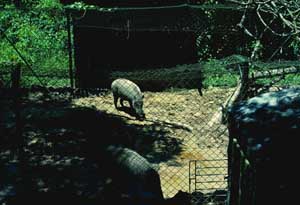|
|
 33 bearded pigs DHJanzen100424.jpg high resolution
|
|
| The mass-seeding, mast-producing Dipterocarpaceae - large rainforest trees throughout Southeast Asia - produce(d) huge seed crops of what were called (high edible) ilipe nuts. These were gathered in great numbers by indigenous peoples to extract oil from them and eat them directly. Produced at intervals of 10-30 years, these huge seed crops were direct analogues to bamboo seed crops (only that dipterocarps are iteroparous, not semelparous, and are largely rainforest trees, whereas bamboos were most prominent in areas of drier to dry tropical forest - such as once covered India, Burma, Cambodia, Vietnam, south China, etc.). And the huge dipterocarp seed crops had their own special pig - Sus barbatus - which occurred in herds of tens of thousands of animals (three lonely individuals in the Malaysian zoo above) and circulated among the dipterocarp seed crops, crossing hundreds of kilometers in a non-reproductive state, and then doing just as did the chickens when they found a seed crop. | ||
back to lecture slides
or skip to: